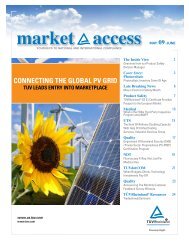market access market access MAR/08/APR
market access market access MAR/08/APR
market access market access MAR/08/APR
You also want an ePaper? Increase the reach of your titles
YUMPU automatically turns print PDFs into web optimized ePapers that Google loves.
<strong>market</strong> <strong>access</strong><br />
Machinery<br />
The EU’s New Machinery Directive And Its Impact On Certification<br />
To Avoid Issues In 2009, Compliance Efforts Should Start Today<br />
Reprinted with permission, this article originally appeared in the January 20<strong>08</strong> issue of Conformity, www.conformity.com , authored by udo<br />
Heinz, (uSA) industrial Machinery Division Manager<br />
The European Union’s (EU’s) new Machinery Directive<br />
(2006/42/EC) is almost here. Adopted by the European<br />
Parliament and the Council of Ministers in June 2006,<br />
it was enforced 20 days later. Since then, conformity<br />
experts have been examining the documents for<br />
differences. On December 29, 2009, the new provisions<br />
will become effective and replace the current version<br />
of the Machinery Directive (98/37/EC).<br />
Fortunately, we have already had some time to test the<br />
waters with respect to this new legislation. For the next<br />
two years, we will see members of the EU adopt them<br />
into national law. Until this adaptation period ends in<br />
December 2009, EU countries are still accepting the<br />
current Machinery Directive as applicable.<br />
Most impacted by these changes are manufacturers<br />
of machines and machine assemblies as well as<br />
machine importers. Specifically, manufacturers of<br />
partly complete machines must abide by the Machinery<br />
Directive and issue a Declaration of Incorporation.<br />
CoNTiNueD oN PAge 13<br />
mar/<strong>08</strong>/apr<br />
12<br />
Additionally, the requirements for machine importers<br />
have also been expanded under this new legislation.<br />
Now, they will need to have a technical file in Europe<br />
and, on the Declaration of Conformity, must list the<br />
machine manufacturer’s name and address, in addition<br />
to the authorized representative’s contact information in<br />
the EU (identical to what is required in the Low Voltage<br />
Directive (2006/95/EC), and the technical file contact.<br />
changes address circulation, advancements and Safety<br />
While the new Machinery Directive has several<br />
consistencies with the current version, there are several<br />
differences between the two – none of which can be<br />
considered radical. Overall, the new legislation focuses<br />
more on free circulation within the EU <strong>market</strong>, as well as<br />
on various health and safety rulings. More importantly,<br />
the new legislation clarifies many passages of text that<br />
were previously considered a challenge for conformity<br />
experts to interpret.<br />
With the new directive, the EU addresses advancements<br />
in machinery that occurred after the current directive<br />
was implemented. As expected, the technology to<br />
produce or run machinery has evolved and the current<br />
directive, as it was written, could not accommodate<br />
some of these technological leaps. Over the years, the<br />
Commission issued guides to update the current directive.<br />
Compliance experts also spent a considerable amount<br />
of time interpreting parts of the directive to make sure<br />
new technology could meet certification requirements.<br />
In time, this methodology became an accepted part of<br />
the industry.













